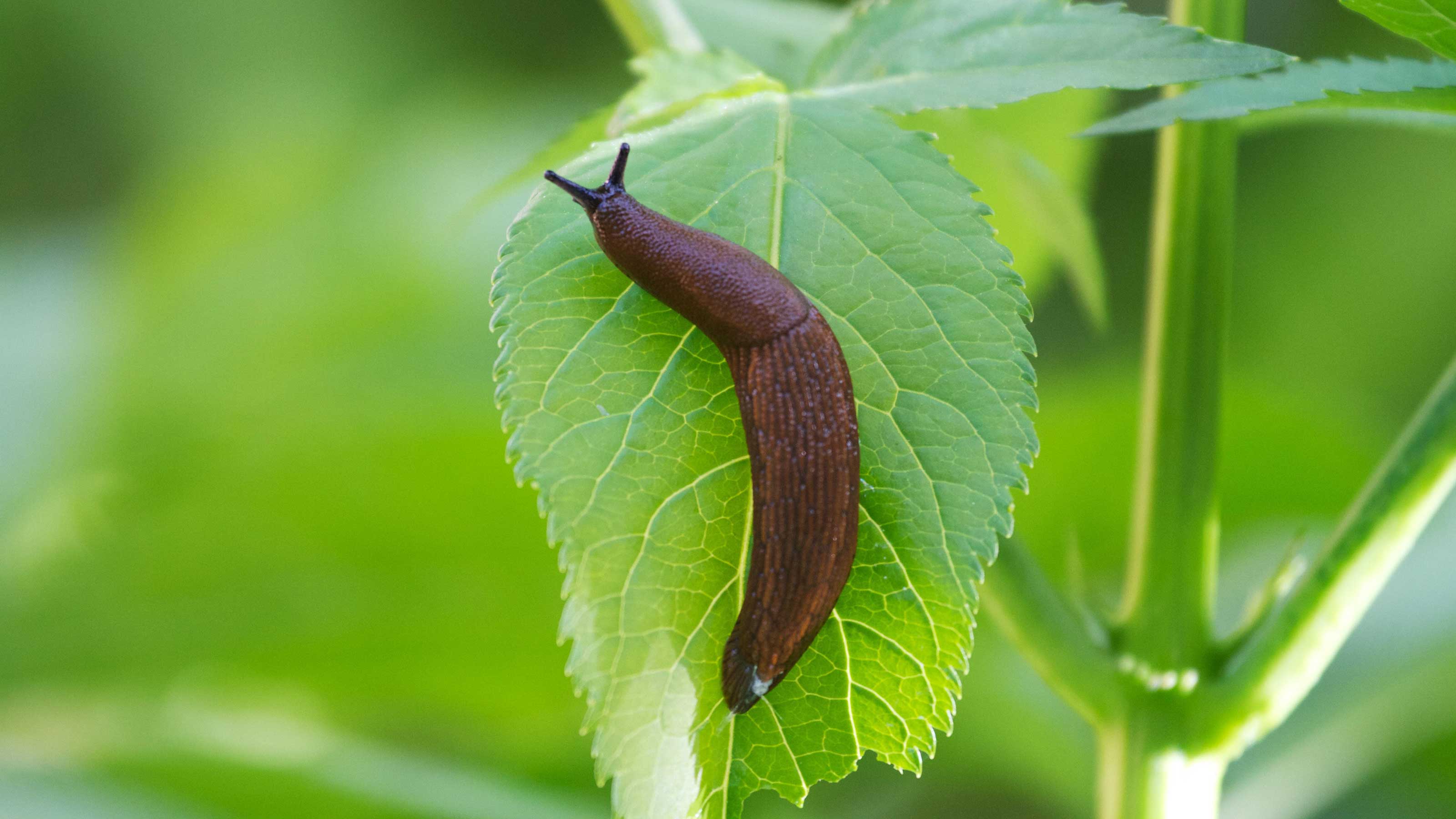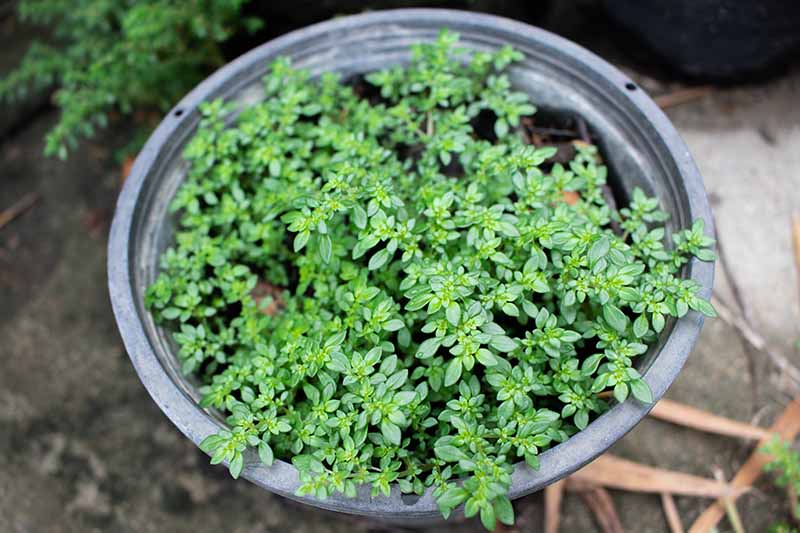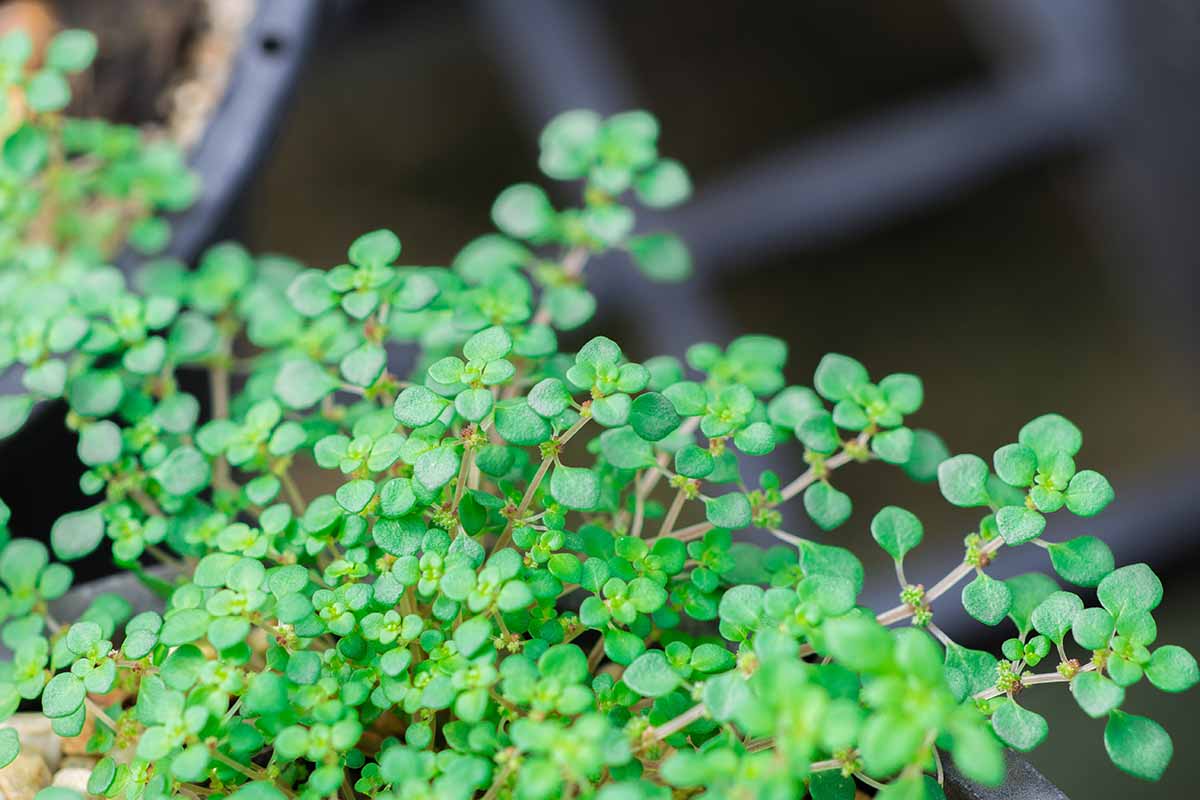Ornamental artillery plant, Pilea microphylla, aka gunpowder or pistol plant, military fern, or rockweed, is an herbaceous perennial.
It is one of about 600 types of non-stinging Pilea species in the Urticaceae, or nettle family.
This tropical species thrives outdoors year-round in Zones 11 to 12 as a short-lived evergreen perennial. It is also grown as an outdoor annual or indoor houseplant in all zones.
We link to vendors to help you find relevant products. If you buy from one of our links, we may earn a commission.
In this article, we’ll discuss all you need to know to grow and care for your own artillery plant indoors.
It has a creeping growth habit and may reach mature dimensions of six to 18 inches high and 12 to 24 inches wide.
The artillery species has plump leaves like a succulent. They are either green or variegated pink and white, one-eighth to one-half inch long, and “obovate,” or rounded and narrower at the base. The leaves are arranged in opposing pairs, like a fern frond.
In nature, the species produces tiny pinkish flowers followed by brown fruits. And while flowering is unlikely to occur indoors, it’s fun to know about it because the names “artillery,” “gunpowder,” “military,” and “pistol” come from an unusual characteristic.
There are both male and female flowers, and the males literally propel pollen into the air, as in an aerial attack.
Historically speaking, the artillery species has undergone numerous botanical reclassifications by Swedish botanist Carl Linnaeus and later botanists, including Parietaria microphylla (1759), Pilea muscosa (1821), P. microphylla (1851), and P. trianthemoides var. microphylla (1869).
These synonyms and “basionyms,” or name equivalents and their predecessors, still pop up in plant searches, so it’s good to be familiar with them.
The artillery species is native to the Caribbean, Mexico, Central and South America, and the southeastern United States.
In its native habitat, it is a somewhat weedy, spreading ground cover that commonly sprouts between rocks and in lawns, in margins between land and water, and in masonry crevices.
The species has been introduced around the world, and is classified as invasive or at high risk for becoming invasive in many places because it readily naturalizes via stolons, or runner roots, as well as self-sown seed.
Today’s cultivated varieties are robust versions of the hardscrabble wild species. And while indoor cultivation does not pose a threat to the landscape, we do not recommend letting P. microphylla spend the summer outdoors in temperate zones as we do with many houseplants, in order to avoid inadvertently introducing it to the landscape.
This tropical species thrives best with a daytime temperature range of 65 to 85°F and 1000 to 2000 foot-candles of daylight, which is another way of saying bright indirect light.
Lower light is well-tolerated but usually causes shading to dark green, so don’t waste money on a variegated variety if you choose a dim location for your plant.
And growth may be more horizontal than upright. A little pruning of leggy stems contributes to a more compact form.
If you have a very dim setting, such as a windowless office, that you wish to add a plant to, you’ll need a grow light.
To grow your own P. microphylla, you’ll need to start from seed, take a stem cutting from an existing plant, divide an existing plant, or purchase a nursery start.
Outdoors, this is a vigorous self-sower that disperses tiny seeds with gusto, contributing to its invasive tendencies.
However, starting from seed may pose a challenge, as most retailers sell live plants and seeds can be hard to come by.
The artillery plant, also known as Pilea microphylla, is a cute indoor plant with tiny leaves resembling coins. Its fun, lively energy makes it a popular houseplant. But like any plant, it can fall victim to pesky garden pests – especially slugs and snails!
These slimy mollusks feed on the tender foliage of the artillery plant, leaving behind holes, shredded leaves, and sticky slime trails. An infestation can quickly damage your plant’s health and appearance.
So how do you banish slugs from your artillery plant? In this article, we’ll explore natural organic techniques to get rid of these garden pests without harming your plants or the environment.
Why Slugs Love Artillery Plants
Slugs and snails thrive in the warm, humid environment indoors. The artillery plant’s lush tender leaves provide the perfect salad bar for these hungry pests!
Certain features make this plant particularly vulnerable:
-
Plentiful foliage gives slugs ample places to hide and feed.
-
Juicy leaves with high water content appeal to slugs.
-
Its indoor habitat means slugs can access it year-round.
-
Large potted plants offer moist soil that slugs need to survive.
-
Smooth pot surfaces allow slugs to easily access the plants.
Unfortunately for us plant parents, the artillery plant’s attractive qualities also draw in slugs! But don’t worry, we can still enjoy this plant by taking the right precautions against these bothersome pests.
Signs of a Slug Infestation
Catching slug and snail damage early allows you to protect your plant before the infestation gets out of hand. Be on the lookout for these telltale signs:
-
Irregular holes in leaves, especially near the bases and edges.
-
Shredded areas on leaves that appear “chewed” away.
-
Silver slime trails on leaves and the pot surface.
-
Actual sightings of slugs or snails on the plant, especially at night.
-
Droppings that resemble small dark dots, usually found at the base of the plant or on the soil.
Inspect the undersides of leaves and the soil surface around your artillery plant regularly for any of these signs. Finding slime trails or two is your cue to take action before damage spreads!
Organic Ways to Eliminate Slugs
Getting rid of the slugs already on your plant is the first step. Here are some safe, effective DIY solutions:
Hand Pick Daily
Go slug hunting! Check your artillery plant thoroughly each day and manually remove any slugs or snails you find. Crush larger ones or drop them into soapy water. Regular handpicking clears out the worst offenders and prevents multiply rapid reproduction.
Set Beer Traps
Slugs can’t resist the smell of beer! Place small containers of beer, buried up to the rim around your plants. Slugs crawl in but can’t escape. Dispose of the dead slugs and refill the traps as needed.
Use Salt or Wool Pellets
Sprinkle diatomaceous earth or crushed eggshells around the base of the plant to shred slugs bodies. Salt kills slugs but avoid direct contact with your plant. Unroll wool pellets near plants as slugs eat them and expire.
Make a Copper Barrier
Copper foil or tape repels slugs. Wrap it around the lip of your planter to block entry. Or make a perimeter around the plant with pennies spaced a few inches apart.
Set Out Slug Bait Stations
Iron phosphate slug baits applied nearby, not on the plant itself, lure in and kill slugs without harming pets or wildlife. Look for child and pet safe options.
Prevent Slugs from Reaching Your Plant
Blocking access is key for ongoing slug control. Make your artillery plant less appealing with these tips:
-
Use pebbles or stones as mulch since slugs dislike crawling over rough terrain.
-
Allow the soil to dry slightly between watering to discourage moisture-loving slugs.
-
Apply petroleum jelly or double sided tape around the inside rim of pots to hinder slugs.
-
Grow plants up on benches or shelves rather than directly on the ground.
-
Keep surrounding area free of debris slugs might hide under.
Regular plant grooming helps too. Prune off damaged leaves and clear away fallen debris where slugs may be lurking. Keeping your artillery plant and the nearby area clean and dry prevents welcoming slugs back.
Organic Slug Sprays
When slugs persist, try these organic DIY spray solutions to repel or exterminate them:
-
Coffee spray – Mix leftover coffee grounds with water and spray on affected plants. Or make batches of strong coffee, let cool, and apply the slug-repelling liquid.
-
Vinegar spray – Straight distilled vinegar kills slugs on contact and deters future infestations. Add a few drops of dish soap so the spray adheres to leaves.
-
Beer and yeast – Let beer and active dry yeast sit overnight, then strain out the yeast. Spray this fermented mixture to deter slugs.
-
Garlic and chili spray – Blend garlic and hot peppers with water. Strain out solids. Spray this irritating solution onto plants to discourage slugs.
Apply these organic sprays directly on slugs already present and as a repellent perimeter around your plants. Avoid excessive contact with the leaves. Repeat applications after rain to maintain effectiveness.
Encourage Natural Predators
Promote beneficial critters that feed on slugs and snails as part of your integrated pest management plan:
-
Ground beetles – Attract these voracious slug hunters by avoiding beetle-harming chemicals and providing protective ground cover.
-
Frogs and toads – A backyard pond or moist refuges draw in these slimy slug gobblers.
-
Snakes – Gardens with rock piles for snakes to bask appeal to slug-eating species like garter snakes.
-
Birds – Set out shallow dishes of beer to trap slugs and snails for garden birds to feast on.
Let these natural slug predators do part of the dirty work in balancing your garden ecosystem for you!
When to Seek Professional Help
In severe artillery plant slug infestations, you may need to enlist professional pest control support. Seek help if you notice:
- Swift damage progression even after implementing solutions
- Slugs in extremely high numbers
- Plant health declining due to loss of foliage
- Slugs spreading to all your indoor plants
- Frustration with lack of success managing the issue yourself
Specialty slug baits and removal tools may better tackle a widespread infestation. A pest control technician can also assess if environmental factors are encouraging slugs and advise adjustments to deter them.
With persistence and a multi-pronged approach, you can conquer the slugs snacking on your artillery plant. Don’t let these sticky pests stop you from enjoying this cheerful indoor plant. Try combining several of these organic control methods to kick slugs out of your garden for good!

Managing Pests and Disease
With indoor cultivation, you are not likely to face many issues. Some common houseplant pests prefer very dry environments, while fungi and bacteria favor dampness.
Try to keep the indoor humidity at or above 45 percent, and avoid both under- and overwatering as well as direct sunlight.
Even with the best care, pests may appear. You may encounter:
Some are more likely to prey upon flora grown outdoors, but you should be aware of the possibilities.
If a stream of running tap water doesn’t dislodge the offending insects, try one or more of the following:
Treat sapsuckers and caterpillars with an application of organic neem oil.
Apply food-grade diatomaceous earth to the soil. It addresses sapsuckers as well as flying pests and gastropods, and remains in the potting medium as a preventative measure against future infestation.
Place yellow sticky tape products formulated specifically for trapping flying pests near affected pots.
In the event of an extensive infestation, you may have to remove severely damaged foliage by cutting stems just above a leaf node or at the base.
As for diseases, the following are known to afflict P. microphylla:
- Anthracnose (Colletotrichum spp.)
- Myrothecium Leaf Spot (Myrothecium roridum)
- Pythium Root Rot (Pythium spp.)
- Rhizoctonia Aerial Blight (Rhizoctonia solani)
- Southern Blight (Sclerotium rolfsii)
- Xanthomonas Leaf Spot (Xanthomonas campestris)
As we said, indoor specimens are less likely to suffer from these ailments than plants grown outdoors.
However, if yours should become infected, there are both chemical and biological treatments for fungal and bacterial conditions that you can try.
If the damage is extensive, it is often better to discard the plant and sanitize the pot with a 10-percent bleach to water solution (one part bleach to nine parts water).
From a Nursery Start/Transplanting
When you buy a pilea, it may be very young or more mature. To transplant it to another container, or to pot up a stem cutting or division, do the following:
Choose a vessel that is large enough to accommodate the plant, whatever its size, with two to three inches of growing room all around it. Be sure that it has one or more drainage holes.
Keep in mind that when it’s mature, this type of pilea may be between 12 and 24 inches wide. You will probably need to repot more than once before maturity and may want to keep the early containers on the inexpensive side.
At maturity, you may opt to select a hanging container to showcase the species’ creeping, trailing nature.
Buy potting soil that’s rich in organic matter, moisture-retentive, loose and airy, and well-draining. It will approximate the 5.0 to 6.0 pH that this tropical species prefers.
Place a single layer of pea gravel in the bottom to facilitate drainage, and then fill the vessel about halfway with potting soil.
Gently unearth the plant from its current pot.
Settle it in the potting medium so it sits at the same depth it was in the original container.
Backfill with soil and tamp it very lightly to hold the plant upright. Take care not to compact the soil. Light and airy is what you want to aim for.
If you are potting a rooted stem cutting, settle it in the soil, taking care not to injure the fledgling roots.
Bury the rooted end one inch deep in soil, tamp lightly and loosely backfill.
To transplant a division, you’ll want to settle it in much the same way, with about an inch of soil over the roots, at about the same height it was in its original vessel.
After potting, water until it runs out the bottom of the vessel, and repeat.
When all drainage has stopped, find a location with bright, indirect light. You may want to place the container on a single layer of pea gravel in a shallow, non-rusting pan. Add water to the pan until it comes just to the top of the gravel.
This is a great way to increase ambient humidity and replicate the natural habitat of a pilea plant.
One final note: With stems that are fleshy like a succulent, it’s easy to bruise or break them, so be sure to handle yours with care.
Once potted and watered, it’s time to apply a half-strength liquid or slow-release granular houseplant food. It’s best to apply this to wet soil to avoid burning tender roots and stems.

Feed again in the summer, and continue to feed once in spring and once in summer going forward.
Some gardeners recommend feeding more frequently, but overfeeding may prove to be a disaster resulting in a visible buildup of salts on the soil and container that inhibits water uptake.
In the event of a buildup, flush the pot through several times with water, and reduce feeding to once a year in the spring.
Keep the soil evenly moist by watering when the surface feels dry. Avoid oversaturation, as the roots rot easily, and reduce watering during winter dormancy. Just don’t let the pot completely dry out.
In addition, avoid wetting the leaves, especially in low-light locations, to avoid creating a breeding ground for the bacterial and fungal diseases we’ll discuss shortly.
P. macrophylla is not hard to grow when you remember to:
- Use an organically-rich potting soil that is loose, well-draining, and moisture-retentive.
- Avoid packing the soil down hard when potting. Instead, tamp loosely and leave lots of air holes to facilitate the flow of nutrients, oxygen, and water.
- Fertilize sparingly to avoid a buildup of salts, and flush several times as needed in the event of overfeeding.
- Maintain even moisture without oversaturation by watering when the soil surface feels dry.
This is an easy species to maintain. For a more compact shape, pinch off a few inches of the growing tips. If you like, use them to make new plants per the propagation instructions above.

If a fragile stem breaks, use clean pruners to remove the damaged portion. Be sure to cut just above a leaf node to encourage rapid regeneration.
Also, tap water is sometimes so alkaline or “hard” that it causes white spots to form on the leaves. If you note this issue, switch to distilled water.
Like many houseplants of tropical origin, P. microphylla thrives in bright, indirect light but it can tolerate a low-light placement.
Photo by Daderot, Wikimedia Commons, via
P. microphylla ‘Variegata’ is a variegated pink and white cultivar you may like to choose for a location with bright indirect light.
P. microphylla ‘Variegata.’ Photo by Forest & Kim Starr, Wikimedia Commons, via
For best results in low light, remember that a green variety is your best bet, as a variegated one is likely to shade to dark green anyway.
This species has not been widely developed, and options and availability are currently not extensive.
Simple Way To STOP SLUGS Eating Your Crops #homestead #gardening #cooking
FAQ
How do you kill slugs but not plants?
What can I spray on my plants to keep slugs away?
How to stop slugs from eating hostas?
